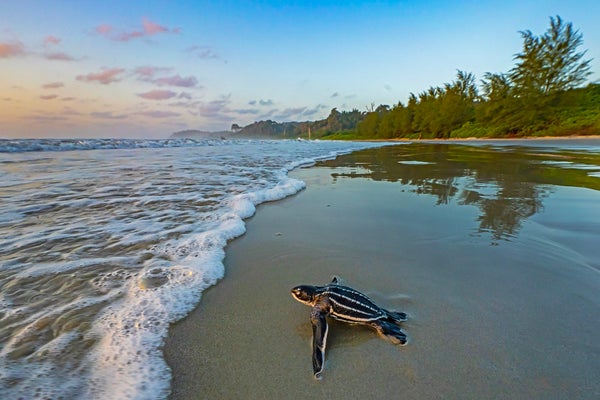In 1667 a Swedish sailor reported that on his travels in the Far East he’d landed on the island of Great Nicobar, whose inhabitants had “a tail hanging like a cat’s tail, but bald, and they could toss it however they liked, like a cat does.” He’d evidently encountered the Shompen, who tie a strip of bark around the waist, letting its end dangle behind them. More than a century later this fanciful account led Scottish philosopher Lord Monboddo to postulate that the islanders were the common ancestors of humans and orangutans (both of which had lost their tails).
Science has since learned more about evolution, but the Shompen remain almost as enigmatic as ever. Numbering anywhere between 200 and 400, these hunters, gatherers and shifting cultivators mostly live in the steep, forested interior of Great Nicobar and shun outsiders. Only fragments of their language, culture and beliefs have been deciphered by academics. This past April seven Shompen men who had emerged from the forest were persuaded to cast ballots in India’s general elections—although they can have little idea what a nation of 1.4 billion people is, let alone what elections are. Nor may they comprehend the danger they are in. As 39 scholars warned in February, the Shompen are facing “a death sentence” that is “tantamount to the international crime of genocide.”
The Indian government, which inherited Great Nicobar Island from British colonizers, is about to build a massive transshipment terminal there. Described as a new Hong Kong, the $9-billion free-trade zone is to include a port with an eventual capacity to handle 16 million cargo containers a year, a town for 350,000 people resettled from mainland India, ancillary industries, a power plant and an international airport to be used by 4,000 peak-hour passengers.
On supporting science journalism
If you're enjoying this article, consider supporting our award-winning journalism by subscribing. By purchasing a subscription you are helping to ensure the future of impactful stories about the discoveries and ideas shaping our world today.
The project will fell close to a million primeval rainforest trees in its initial phase alone and ultimately spread over 244 square kilometers—nearly a fifth of Great Nicobar. It’s not only the Shompen who will be devastated. The island is also home to the Great Nicobarese, an Indigenous people who lived mainly along the southern and western coast until the massive tsunami of 2004 washed most of them away. The survivors were evacuated to the eastern coast, where they reunited with compatriots who returned from studying or visiting elsewhere. The Great Nicobarese have long pleaded with the Indian government to be allowed to return to their ancestral lands. But these are to be subsumed by facilities associated with the complex.
Just as worrisome, this emerald drop in an ink-blue ocean, one of the most pristine places left on Earth, is “globally irreplaceable from a biodiversity conservation viewpoint,” according to the Alliance for Zero Extinction. The silver-sand beach edging Galathea Bay, at the southern end of Great Nicobar, for example, is the Northern Indian Ocean’s largest nesting site for endangered Leatherback sea turtles, a species so venerable that it’s shared Earth not only with us but also with the dinosaurs. This exquisite bay, which contains at least 117 species of corals, is to be dredged and developed into the container terminal, a seawall almost entirely blocking its entrance—a death trap for marine animals.
Great Nicobar is a also a UNESCO biosphere reserve and part of the Sundaland biodiversity hotspot, a region whose extraordinary biodiversity inspired the evolution theory of Alfred Russel Wallace, Charles Darwin’s great rival. Of the more than 2,500 species of fauna and flora thus far documented on the island, 17 percent are endemic—found only on Great Nicobar or sometimes also on the other, far smaller, islands of the Nicobar archipelago.
Environmentalists have warned that the clear-cutting, blasting, dredging, construction, dumping of debris, ship traffic, pollution of multiple kinds and the enormous influx of outsiders with their animals and germs will devastate the Indigenous people and the creatures who live on and around Great Nicobar. No matter: after Prime Minister Narendra Modi announced the project in August 2020, his government shepherded it past all regulatory and legal hurdles, in such haste that it repeatedly tripped over itself.
In January 2021, for instance, India’s minister of environment, forest and climate change released a document listing Galathea Bay among the most important marine turtle habitats in India—apparently unaware that a wildlife board, which he also headed, had days earlier revoked the bay’s protected status. All that happened long before a private firm with no experience in conservation published an omission-ridden draft of an environmental impact assessment (EIA) in December 2021. Among other things, the EIA failed to mention all but two of the 15 species of dolphins and whales spotted in waters near Great Nicobar.
The sequence of events indicates that the Modi government selected Galathea Bay as the project site with no consideration of how it might affect either Indigenous people or wildlife. Nor does it seem keen to understand the full impact. Government-affiliated scientists seem to still have access to Great Nicobar, but for independent researchers, obtaining permits to work on the island has become like “getting a ticket to the moon,” one observer says. Earlier this year a senior official entrusted with protecting Indigenous rights blasted the project’s critics as being part of “an international conspiracy.”
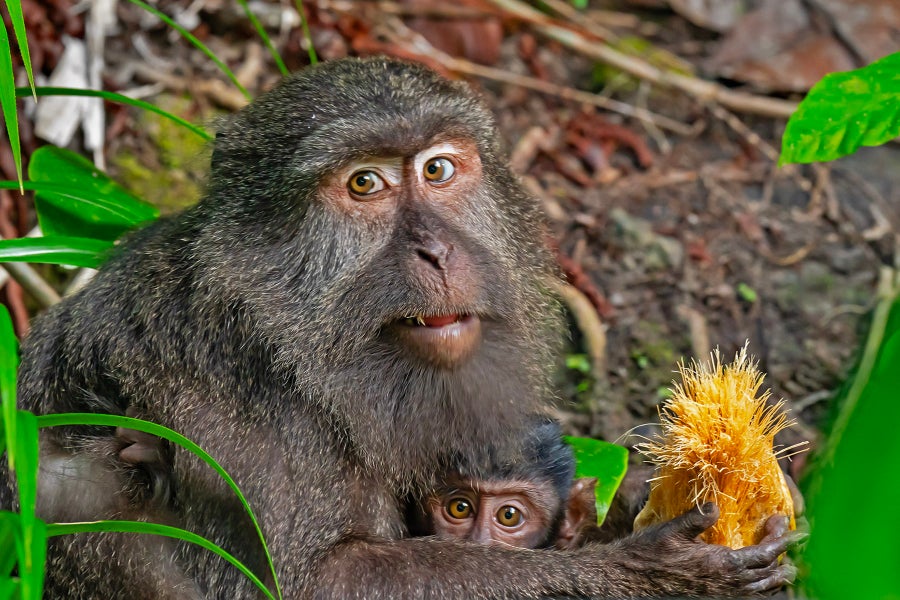
A Nicobar Long-tailed Macaque and her baby eat a pandanus fruit. These ingenious monkeys use leaf fibers to floss their teeth, twigs to scratch their back and rocks to break open coconuts. They live only on Great Nicobar and two smaller islands.
Dhritiman Mukherjee
I’m no conspirator; I’m just in love with this part of the world. Two decades ago I wrote a book about the hunter-gatherers of the Andaman archipelago, which lies north of the Nicobar Islands. (A few of the Andaman islanders enforced their voluntary isolation, essential for their survival, by killing an American missionary in 2018.) Great Nicobar has always been less accessible than the Andamans, except to Indian government officials and former defense personnel and their families, who were granted land parcels around Campbell Bay on the east coast, mainly in the 1970s. The Indian navy built an air station near the bay in 2012.
I’ve never visited the Nicobars. But over the years, as I heard tales of the elusive Shompen and of the island’s strange birds and animals, I came to think of Great Nicobar as a magical world rather like Pandora of the Avatar movies—complete with Indigenous peoples, luminous mushrooms, majestic trees thousands of years old, and mysterious creatures of the forest, coastline and deep. To me, the “development” planned for this island is as much of a desecration as the invasion of Pandora.
The Andaman and Nicobar island chains are peaks of an undersea mountain range scraped off the ocean floor over millions of years as the Indian geological plate pushes under the Eurasian. As small green havens in a vast ocean, they’re already a marine and aerial hub—with Great Nicobar being particularly significant.
Migratory birds using two great flyways, the Central Asian and the East Asian-Australasian, throng the island’s shores and wetlands. And tracking by ecologist Kartik Shanker and his team indicates that every year thousands of Leatherback hatchlings travel from beaches on the Andaman and Nicobar Islands across the Indian Ocean, either 10,000 kilometers west to Madagascar and Mozambique or east to Indonesia and Australia. Decades later, as adults weighing up to a metric ton, the Leatherbacks return to their natal beaches to lay their own eggs. Human ecologist Manish Chandi has described as “supernatural” the spectacle of these leviathans hauling themselves out of the sea on a winter night to continue a cycle of life honed over millions of years.
Great Nicobar’s surrounding waters have been only partially explored by naturalists. They contain some of the most pristine coral reefs in the world, with 273 documented species of stony corals, among which live, along the eastern coast alone, 256 species of fish. The coral reefs, sea grass beds, and craggy undersea ridges and valleys, sloping into inky depths on either side of the island chain, shelter and nourish “an incredible diversity” of marine mammals, says marine biologist Mahi Mankeshwar. Apart from the dugong, a manatee sibling and a distant relative of elephants, these include the Indo-Pacific bottlenose, Spinner, Pantropical Spotted, Risso’s and Fraser’s dolphins, orcas and false killer whales, Omura’s whales and the enigmatic sperm whale.
Almost nothing is known about the region’s sperm whales. But in other parts of the world, close-knit pods of female sperm whales and their offspring live mainly in tropical waters, communicating via clicks so structurally complex as to suggest a language. Different pods may even have different dialects. Young males leave their maternal pods to form “bachelor schools,” gradually migrating toward the poles and becoming more solitary. As adults, they roam freezing polar waters or travel thousands of kilometers to tropical seas to seek females, spreading their genes around the globe.
What will the transshipment project do to aerial and marine visitors to Great Nicobar and its surrounding seas? Conservationists’ detailed critique of the EIA offers a clue. The star of the East Asian-Australasian flyway, the Bar-tailed Godwit, can fly nonstop for more than 13,000 kilometers. But most migratory birds need frequent stops for nourishment, and, according to ornithologist Shashank Dalvi, coastal development in China has already destroyed many feeding grounds. Some species may not survive the loss of yet another link in this vital chain or the likely oil spills.
Shanker holds that Leatherback turtles are savvy enough to stay away from Galathea Bay if they sense disturbances there. That may spare most of them from collisions with ships, but they’d lose an idyllic nesting beach, places that are increasingly hard to come by. The species is already endangered by multiple other threats, such as drowning in fishing nets and climate change.
Coral reefs in Galathea Bay, home to myriads of weird and wonderful creatures, will be destroyed, and those for kilometers around will be smothered by silt or harmed by turbidity and water pollution. Bottlenose dolphins, often seen in the bay, and Omura’s whales—two species that live in coastal waters—will lose their habitats. As for the other species of dolphins and whales in surrounding seas, described as “one of the last reserves of undisturbed marine mammal populations in the world,” their survival will be threatened by, to name just a few factors, collisions with ships, undersea noise and oil spills.
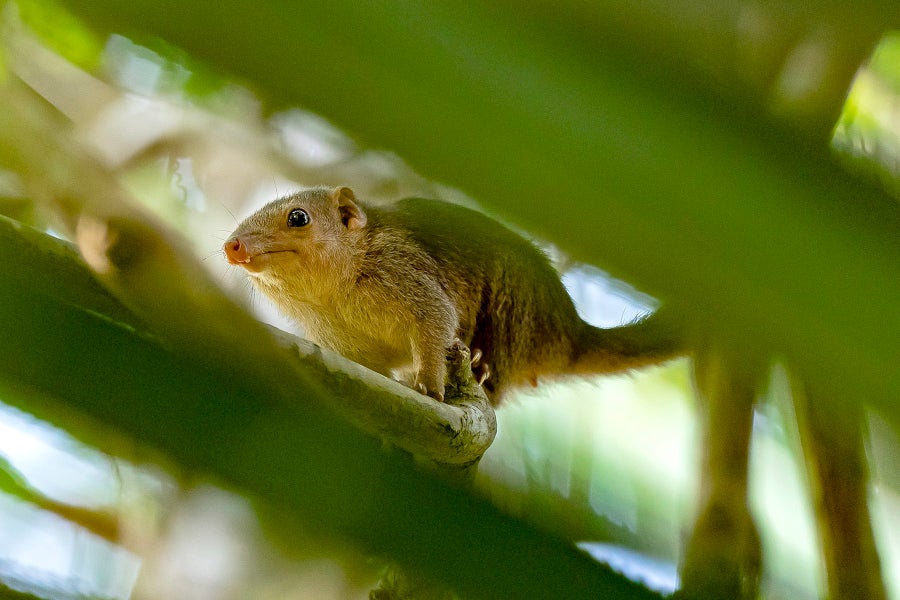
The Nicobar Tree Shrew, found only on Great Nicobar and Little Nicobar islands, is so wary of predators following it to the nest that it feeds its young only every two or three days.
Dhritiman Mukherjee
One would think the aerial and marine visitors to Great Nicobar and its shores would alone preclude major development. But the creatures and plants native to the island, most of which evolved in isolation to yield a cornucopia of unique species, are just as intriguing—and so varied that entire books have been devoted to describing them.
Great Nicobar’s endemic mammals include characters such as the Nicobar Long-tailed Macaque. Around 1900 these monkeys encountered a white explorer and aggravated him by throwing their hands on their face with “an expression of absolute horror,” among other gestures “indicative of shocked and outraged feelings.” Masters of tool use, these primates extract fibers from leaves to floss their teeth, scratch their backs with twigs and break open coconuts with rocks. So ingenious are they that, when raiding settlers’ farms and orchards (which, to be fair, occupy land cleared of pandanus groves that the macaques used to feed on), they avoid attention by breaking up into small groups, each of which snacks discreetly on a different type of fruit or vegetable.
Then there are Nicobar Treeshrews, sentinels of the forest that, in the words of zoologist Louise Emmons, “border on the neurotic,” squeaking maddeningly whenever they spot an intruder—and outing naturalists trying to hide in painstakingly camouflaged hideouts. So skittish are they that, fearing a predator might follow them to their nest, they feed their young for only a few minutes every two or three days.
Another endemic mammal, the Nicobar Flying Fox, is one of the world’s only two known species of Pteropus fruit bats that is solitary in its roosting habits. According to a Great Nicobarese legend, an old lady was feeling cold and sick, so someone offered her a blanket. Eventually she got better and the weather got warmer, but by then the blanket was stuck to her back. Feeling unattractive in it, she began to venture out only at night, when no one else could see her. To this day, she roams the forest every night as a bat and protects it.
Great Nicobar is also classified as an important bird area in categories A1, “known or thought regularly to hold significant numbers of a globally threatened species,” and A2, “known or thought to hold a significant population of at least two range-restricted species.” Among the birds, the Great Nicobar Serpent Eagle (the world’s smallest eagle), the Nicobar Jungle Flycatcher, the Nicobar Scops Owl and the Nicobar Parakeet live only on Great Nicobar or its small sibling, Little Nicobar. The iridescent Nicobar pigeon, a zoo favorite, is a relative of the dodo.
The idiosyncratic Nicobar Megapode lives as mating couples in forests near the coast, building mounds of sand, corals and plant debris to lay their eggs in. The rotting vegetation provides warmth to incubate the eggs; the female periodically checks the temperature with her feet to make sure it’s optimal. Once the chicks have dug their way out of the mound, the couple spruces it up for the next brood. At least 50 of the 95 permanent nesting sites will be subsumed by the transshipment complex.
I won’t start with the freshwater fish, reptiles, amphibians, insects and other arthropods and plants that are unique to Great Nicobar—the list is too long. One exception to note is that, curiously for a tropical island, Great Nicobar has no poisonous snakes. (But there is a type of reticulated python, which the Shompen eat.) Another is that the world’s largest land crab lives here, too; it climbs coconut trees, nips off coconuts, retrieves them on the ground and cracks them open to eat the white flesh. And the Andaman water monitor somehow found its way here—but skipped the northern and central Nicobar islands.
Many of these creatures could be exterminated by the project. One of its most destructive aspects is the enormous influx of outsiders. On the Andaman Islands, for example, newcomers cleared forests for settlement, reducing humidity and precipitation and causing water shortages that have also plagued them. Along with them came animals like dogs and cats that prey on vulnerable creatures like sea turtles and nesting birds. Another danger is disease transmission: avian cholera killed many domestic fowl in the Campbell Bay settlement in 1997, birdwatcher Uday Mondal noted in an article, and some megapodes also seemed to be affected. But there is no record of how the megapodes fared.
A related problem is garbage. Dumping from the Campbell Bay settlement, with its population of about 6,000 (as measured in 2011), is already causing problems for locals. Having lost their former feeding grounds to urbanization, and with some of the settlers shooting, poisoning or electrocuting them to deter raids on plantations, the macaques sometimes feed on trash; they could get sick. The EIA describes the macaques as a “menace.” If that’s how the designated protectors of wildlife see these primates, which the International Union for Conservation of Nature classifies as “vulnerable,” the chances of the Nicobar long-tailed macaque surviving alongside hundreds of thousands of settlers is slim.
In sum, the creatures that can will flee to the mountains, where they will displace others; those that can’t will die. With its interior forests and streams still largely unexplored, chances are this wildlife paradise has many treasures that could be destroyed before they are documented. Every zoological or botanical expedition finds new species, including, this past January, an endemic flowering plant.
“We’ve barely scratched the surface,” Chandi says.
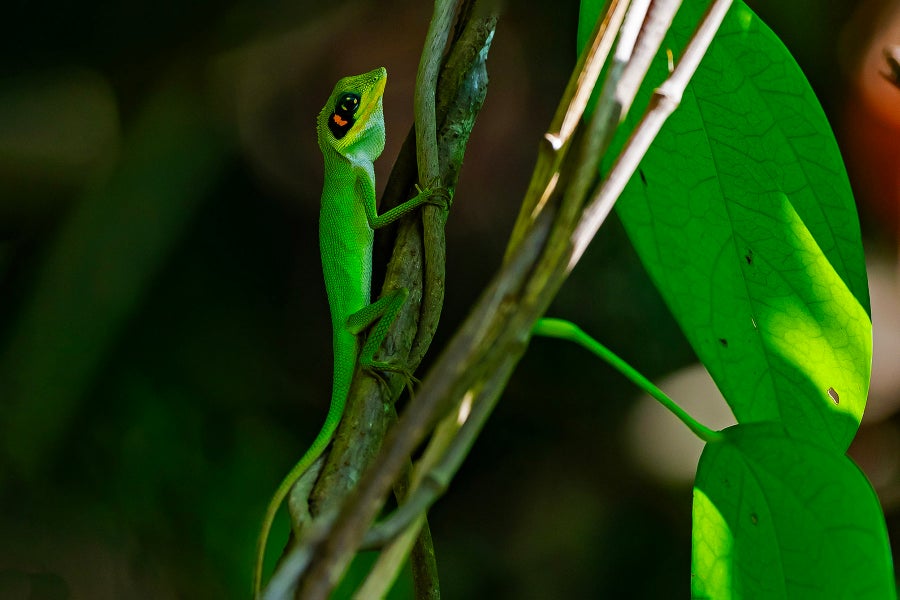
Sometimes called Daniel’s Forest Lizard (Bronchocela danieli), this species lives only on Great Nicobar Island.
Dhritiman Mukherjee
Of all Great Nicobar’s inhabitants, the most enigmatic may be our fellow humans, the Shompen. Steep hills, dense jungles and malaria have defeated most adventurers who have sought to visit their interior settlements. Still, the tales these travelers brought back, as well as accounts collected with the help of the Great Nicobarese, offer a rough sense of how the Shompen live.
They spear crocodiles, fish, and other animals and gather fruit and other edibles. Curiously (and unlike the Andaman islanders), the Shompen don’t use bows and arrows. Only partly nomadic, they build huts on platforms, usually near pandanus groves, which in turn are found near streams. They tend to the groves and, in small patches, cultivate tubers and vegetables.
A few Shompen men, possibly from different groups within the forest, traditionally visited the coastal Great Nicobarese villages to exchange jungle produce such as cane and honey for iron tools, tobacco, cloth and other goods. The coast dwellers, in turn, acknowledged Shompen guardianship of the jungle by, for example, seeking their permission before cutting a tree there, anthropologist Ajay Saini has noted.
Decades back, when the Indian government cleared space for settlers near Campbell Bay, it cut down pandanus groves that the Shompen had nurtured and displaced several of their hamlets. Nowadays the authorities offer the shifting cultivators rations of rice and lentils, which, again, a handful of men arrive to collect. But the Shompen refuse to allow outsiders to follow them back into the jungle. At some point, “they stop and stay put until we move away, or they just pack up their belongings and disappear” into the forest, Chandi relates.
So impenetrable is the terrain that each Shompen band, consisting of a handful of families, is isolated enough to possess its own dialect. Linguist George van Driem reviewed compilations of Shompen words to conclude that their language, like those of the Nicobarese, belongs to the Mon-Khmer branch of the Austroasiatic family, spoken mainly in Vietnam and Cambodia. Genetic studies support this view, while adding detail. They show that the Shompen and the Nicobarese descend from the same founding population originating in Southeast Asia. Unlike the Nicobarese, however, the Shompen have been genetically isolated for about 14,000 years, except for an influx of Y chromosomes—that is, male DNA—about 3,000 years ago.
Genes say little about geography, geneticist T. Sitalaximi cautions, but it seems reasonable to infer that the Shompen’s ancestors were isolated since arriving on Great Nicobar about 14,000 years ago. The men who merged with them 3,000 years ago were closely related to the Indigenous Aeta of the Philippines and the Semang and Orang Asli of Malaysia, according to Sitalaximi—peoples whom earlier scholars had mistakenly, it seems, linked with the Andamanese.
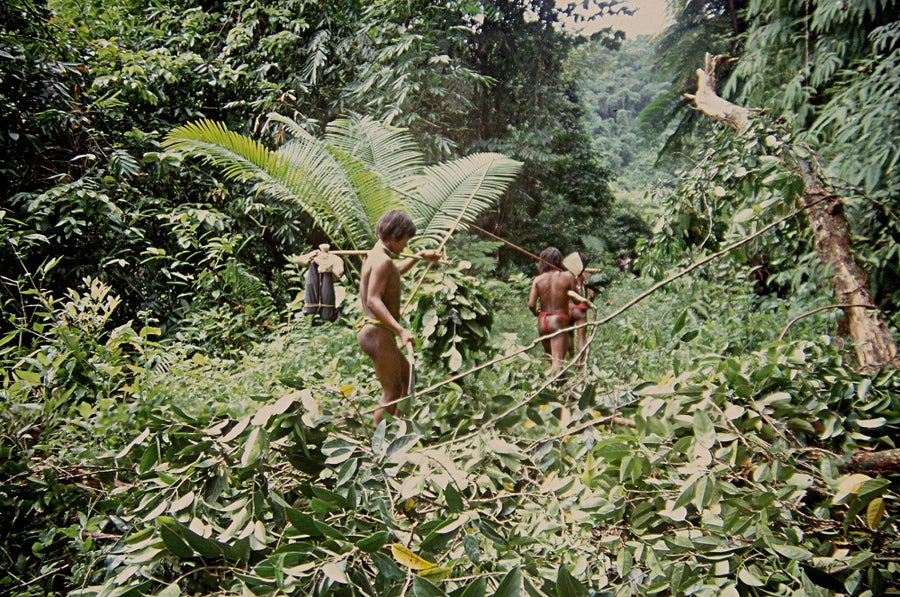
Shompen men carrying honey collected from the forest and shrimp caught in a stream walk to one of their camps. Shortly after human ecologist Manish Chandi took this photograph, they indicated he should follow them no further and vanished into the forest.
Manish Chandi
Although the Shompen are understandably wary of outsiders, the Nicobarese have traditionally welcomed them. Before the 2004 tsunami, they lived in peaceful beachside villages, crafting canoes to travel to nearby islands and to fish in the coral reefs. They raised pigs, grew vegetables and nurtured coconut groves. Ancient seafarers traveling along trade routes between China and India, or even as far west as the Roman Empire, routinely stopped on the Nicobar Islands to stock up with coconuts and other supplies.
Around 1292 Marco Polo landed on one of the islands, possibly Great Nicobar, and later reported that the people possessed magnificent lengths of colored silk, which they bought from passing merchants. They didn’t use the cloths to adorn themselves—they were naked—but kept the sashes “hung over rails in their houses as a token of wealth and magnificence.” Their island was munificent: its “noble trees of great worth” included “red sandal, coconuts (which among us are called Pharoah’s nuts), apples of paradise, cloves, brazil, and many other good trees.”
I’ve never visited the Nicobars, but I, too, have been graced by Nicobarese hospitality. One blistering afternoon in May 1998, I was returning from a visit to a beachside settlement of Onge, the Indigenous people of Little Andaman Island. The path was sandy, so I kept falling off my man-sized rented bicycle; the rainforest’s canopy trees had been felled by a government-owned corporation, so the sun blazed down; and my water supply had run out. I was utterly drained by the time I dragged my bike into a Nicobarese village on the way back. A young woman standing by one of the elevated huts beckoned to me; with a single stroke, she sliced open a coconut and offered it. “I drank gratefully of the cool water, sugar and salt,” I wrote in my book—all that I needed to be on my way.
On December 26, 2004, when the tsunami hit, it washed away all but nine of the Great Nicobarese who were living on the western coast. Among the survivors were Mathias, his girlfriend and his brother, who were in a canoe at sea, rowing back home after having spent Christmas night partying at another village. Thrown onto the island by the waves, they found everything destroyed. Wretched and hungry, they trekked uphill to the nearest Shompen settlement, which was unscathed. The forest dwellers gave the brothers a knife and a pair of fire-making sticks. Over the next week, the trio met up with six other survivors. The implements gifted by the Shompen enabled the five men and four women to hold out for 35 days on turtle eggs and wild boar until Chandi and others arrived in search of survivors.
Mathias now serves as an interpreter, translating between Hindi and Shompen. It was through him that anthropologist Vishvajit Pandya asked a Shompen man what he thought about development. “If you must cut the jungle, cut it along the coast. Do not come near our hills,” the man replied forcefully. “Do not climb our hills.”
But the power plant and airport the Indian government plans to construct will consume two or three Shompen hamlets near the Galathea River, which drains into its namesake bay, as well as two wetlands teeming with waterbirds and saltwater crocodiles, where the Shompen hunt and forage. The displaced bands will be forced to move upstream, sparking competition for resources and conflict with other Shompen groups, Chandi worries. The effluents from the power plant will most likely poison the surrounding soil and the river, where the Shompen fish and collect drinking water.
The forest dwellers will also, and inevitably, encounter construction workers and other outsiders, probably with dire consequences. Sexual violence committed by settlers has been a serious problem on the Andamans and could become one on the Nicobars as well. Worse, having lived largely in isolation, the Shompen have little immunity to the diseases that thrive in the outside world and could be devastated by epidemics, as happened with the Andaman islanders. Whatever microbe killed nearly 100 Shompen in the 1980s of diarrhea probably originated with the Campbell Bay settlement; more epidemics are inevitable.
The Great Nicobarese are less susceptible to infections but suffer from a multitude of ailments, such as heart disease and diabetes, because of altered diet and lifestyle since having been evacuated to Campbell Bay. They have long pleaded with authorities to be allowed to return to their former villages. But this section of the southwestern coast is earmarked for tourism and other facilities. “We feel helpless and abandoned and are extremely anxious about our future,” the tribal council wrote to the chief administrator of the Andaman and Nicobar Islands in August 2022.
After news of the Great Nicobar project broke, Indian civil society launched a passionate and deeply informed campaign to save the island. Partly in response to its concerns and to meet regulatory requirements, the Indian government has announced mitigation measures that range from the ridiculous to the outrageous. The damage to Great Nicobar’s millions-year-old rainforest is to be compensated for by afforestation on dry hills of western India, which has a completely different ecology and will do nothing to save the island’s species. And whatever Shompen territory survives is to be protected from poachers by erecting a “state of [the] art Geo fencing solution equipped with Optical/Thermal cameras, Satellite Phones, Drones”—a militarized border that will terrorize the Indigenous people into staying away from their own spaces.
Yet another response is to set up new wildlife sanctuaries on three small islands off the northern coast of Great Nicobar. That might seem like a good idea—but the devil is in the details. Meroe Island is to be a coral sanctuary, although its coral diversity is unknown. Menchal Island is now a megapode sanctuary, but it has two pairs of megapodes at most and cannot compensate for the loss of Great Nicobar’s megapode population. Three beaches on Little Nicobar will be a Leatherback sanctuary. Leatherbacks already nest on a few of Little Andaman’s beaches—which are too small to host the roughly 1,000 females that will be displaced from Galathea.
Bizarrely, these three islands will now be off-limits to the Great and Little Nicobarese, who have traditionally used and protected them. “Our customs and practices have ensured the integrity of all life on these islands,” they protested in a letter to Indian authorities. Menchal, for instance, is guarded by a spirit named Pingaeyak, and Meroe is cared for by a community elder. Similarly, a hunting taboo protects dugongs near the seagrass beds to the north of Great Nicobar, where the highly endangered mammals feed. “That’s why the dugongs still thrive there,” Chandi says.
Given the Modi government’s track record, the disregard for the environment and Indigenous rights implicit in this massive project is not surprising. What is remarkable is its impracticality. Take the matter of geology. Scientist and journalist Pankaj Sekhsaria has pointed out that the 9.1-magnitude earthquake of 2004 sank the southern tip of Great Nicobar by around four meters. Even without a tsunami, another major earthquake on this very active fault could destroy the township and kill hundreds of people.
Former army officer and senior administrator M. G. Devasahayam has further argued that a container terminal on Great Nicobar is “neither economically viable nor financially feasible.” The enormous construction cost, most of which the Indian taxpayer is expected to bear, will take at least 50 years to pay off because the container terminal, which has no hinterland to absorb or export goods, will struggle to draw traffic away from established ports such as Colombo. (And that’s assuming climate change hasn’t done away with the global shipping industry by 2074.) India’s shipping ministry, which revealingly advertises the project as a once in “a lifetime opportunity for investors to reap gold,” had announced that, should the Modi-led Hindu nationalist alliance win the elections—which it has—the ministry would invite bids for the complex by July and begin construction by the end of the year.
I have listed, as objectively as I can, many reasons why this is not a good idea. I can also point out that the Global Safety Net, a blueprint to “solve the twin crises of biodiversity loss and climate change,” lists the southern end of Great Nicobar, including Galathea Bay, among the areas requiring protection. I can note that six out of nine planetary boundaries have already been crossed, that tropical rainforests store humungous quantities of carbon, that heat waves aggravated by climate change have already killed hundreds of people this year, that deforestation can spread novel viruses that most people have no immunity to, or that no one knows just when biodiversity loss will reach a tipping point so that the entire web of life unravels.
I can rage: with birds and monkeys falling dead from trees, fish floating up in the millions, forests burning and corals bleaching because of overheated summers—how does it make sense to willfully destroy rainforest and reefs and mangroves and beaches with their myriad irreplaceable creatures? Or the rare cultures in which people know how to live in this world with love for other beings rather than contempt?
In truth, perhaps I care about this island, which I have never seen and probably will never see, because it reminds me that living on this Earth, so battered and yet still so beautiful, so full of mystery and magic, is a privilege. That we need to hold onto this magic, because without it life will be just a little bit less worth living.
